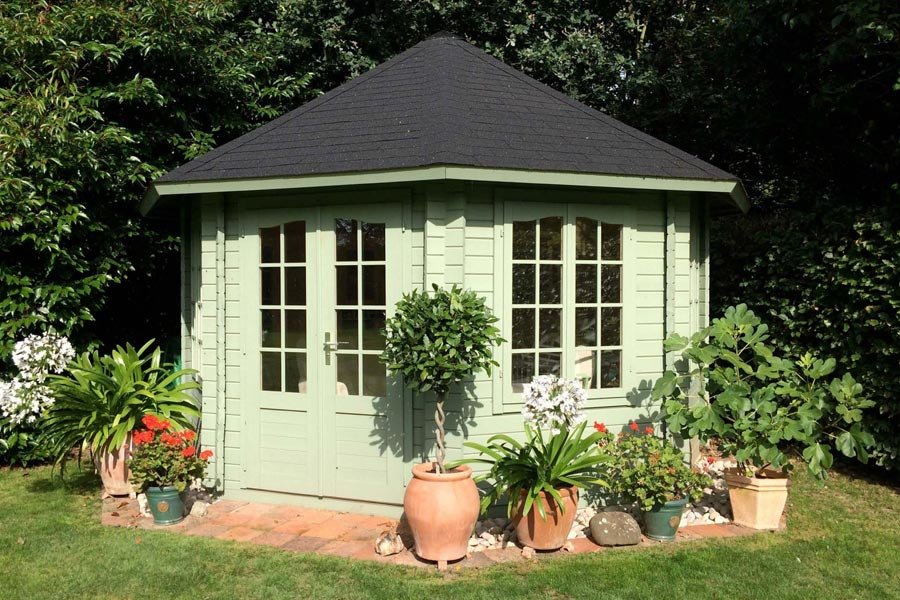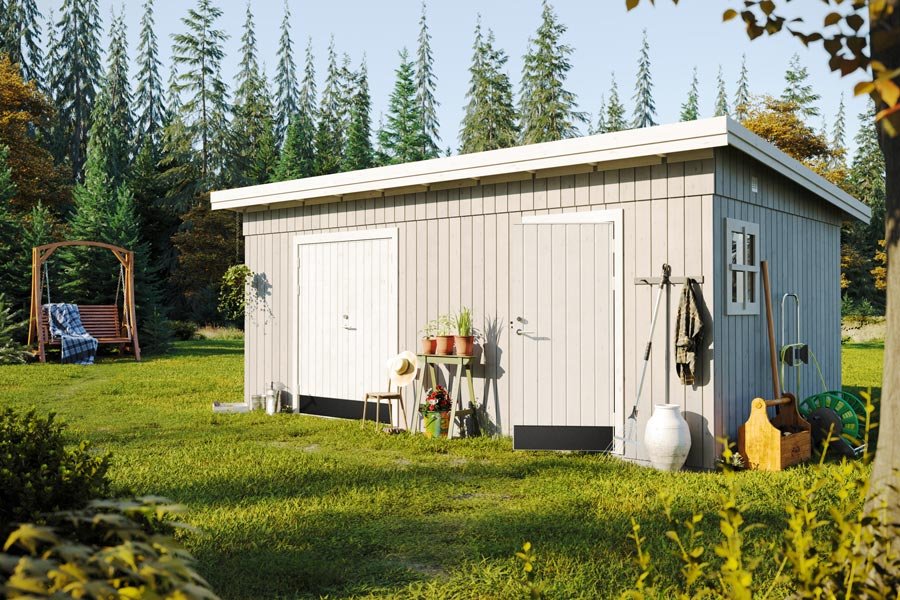
by Mark Bailey | May 13, 2019 | GardenLife Magazine

Buying a garden gazebo in the UK
Cheap or quality? Pop-up or permanent? Metal or timber?
Thinking of buying a garden gazebo in the UK? If you live somewhere windy, where rain regularly comes at you diagonally, a wooden garden gazebo may not be for you. But if you live anywhere else, it could be your ideal solution for garden living.
The Americans love gazebos because they provide shade from the sun. In the UK, we love them because they shelter us from rain as well.
They also offer a degree of privacy, without you having to go the whole hog and buy a summer house. That’s why gazebos are so popular for garden hot tubs and barbecues. But we’re getting ahead of ourselves here. First, let’s go back to basics and say what they actually are.
The short answer is that a gazebo is an open-sided garden structure with a roof – a pavilion or summer house without walls. If you want to know the precise difference between gazebos, pergolas, pavilions and the like, there are more detailed descriptions on The Spruce website. But to our minds, there are more important questions to think about:
How can a gazebo help you get more from your garden?
How should you go about choosing a garden gazebo?

Gazebos and garden living
So, let’s look at the first question, how could a gazebo help you get more from your garden. We’ve already said a gazebo could protect you against sun, rain, and curious eyes. You could use it to do yoga, lounge with a good book, shelter a barbecue, sitting or dining area, or provide a covered play area for the kids (that’s if the hot tub has not got there first).
In other words, it can turn your garden into an extra living space.
A gazebo can also be a focal point for a garden design – the eye is drawn towards it, but the open sides allow you to see beyond to the rest of the garden as well.
How to choose a gazebo for the weather in the UK
Old-fashioned gazebos were permanent structures, built of wood, brick and/or cast iron. But that all changed with the advent of the ‘party gazebo’ – lightweight, pop-up gazebos that are now a staple of parties, school sports days, fun runs and anything else that takes place in the open air in the British Isles.
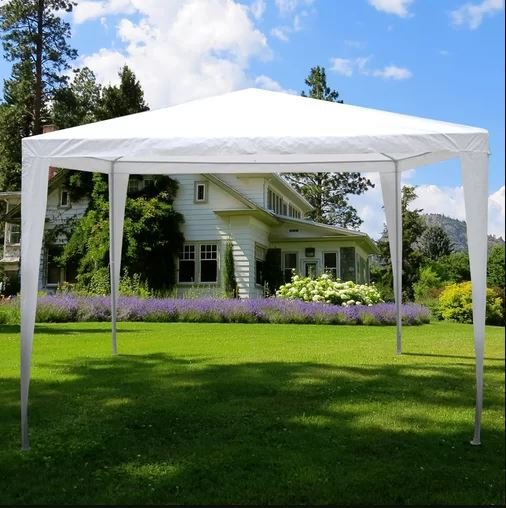
Prices for these start from about £20, though that will likely get you something flimsy that won’t survive more than a gust of wind that’s typical in a UK summer.
There are also more upmarket and robust versions of the temporary gazebo, with design styles modelled on marquees, safari camps or vintage garden fetes. These tend to cost from £100 upwards, depending on size and sturdiness.

Then you get semi-permanent models – with sturdy aluminium, steel or cast iron supports, and available in contemporary designs as well as traditional. These work well on patios as well as lawns, and may run into hundreds of pounds.
A great selection of different styles is available on the Wayfair website, and there’s also a useful blog with reviews of different temporary gazebos.
Permanent metal or timber garden gazebos
What if you want something more robust and longer-lasting, a gazebo that won’t blow away or buckle if the wind blows?
If you really want permanence, you’ll be looking at bricks and cast iron – like a Victorian bandstand. More feasible for most of us, though, is a high-quality timber gazebo, built to withstand the damp English, Scottish or Welsh climate. Below we look at a few of the factors to think about when buying a garden gazebo.

What you’re going to use it for: do you want a completely flexible open space, where you can sit with deckchair or book one day, or lay out a table of party food another day? Or do you want it as a shelter for a hot tub? If you’re planning a hot tub, GardenLife sell a gazebo with a back wall that provides extra privacy and shelter from the wind.

Whether you want a floor: the answer to the above will help you decide this; so will your budget. On some models, the floor comes as optional, so you’re free to decide which would suit your plans and price range.
How much space you want: you’ll want to balance flexibility vs aesthetics vs budget. And you don’t want too big a structure to over-dominate a garden. And your kids won’t thank you if you ruin their back-garden football games with a gazebo plonked in the middle of the lawn (though technically the open sides mean it shouldn’t stand in the way of a curling free kick).
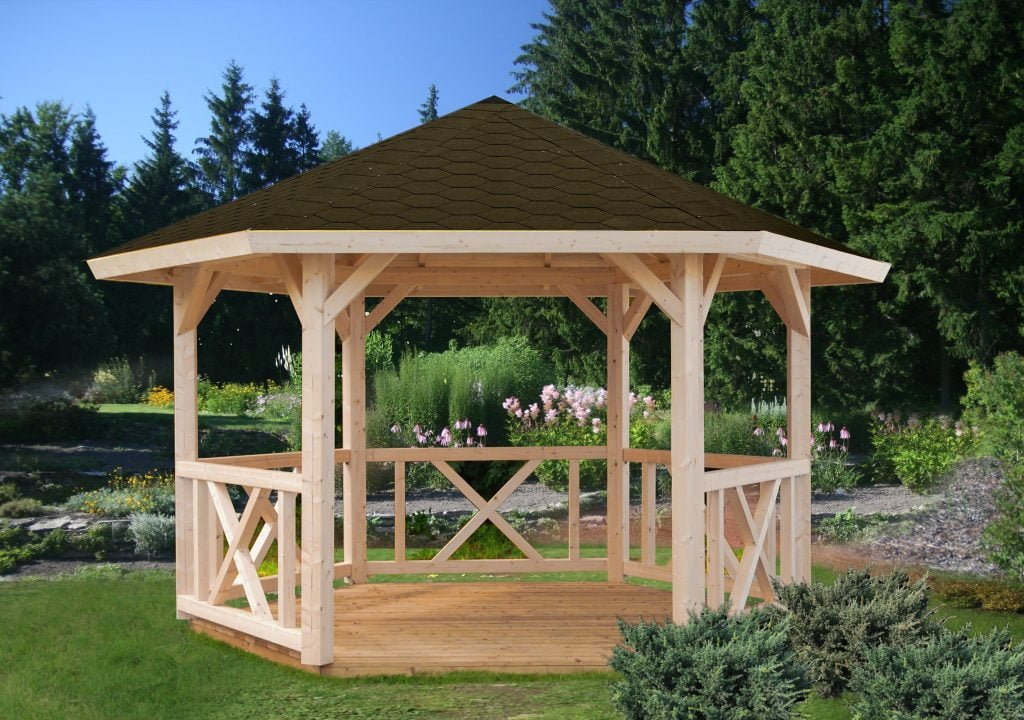
The best shape for your garden: a simple four-sided gazebo is cost-effective and practical but it can look quite plain and functional. A hexagonal gazebo or octagonal shape will look softer and make an attractive centrepoint. If you take a look at GardenLife’s Betty gazebo, you’ll see for yourself how the same design takes on a very different character depending on which shape you go for.

Traditional vs contemporary: the usual advice is that the gazebo should reflect the style of your home – so a period home gets a period-style gazebo. But don’t feel trapped by that – you could set up a good contrast in the same way that a contemporary bathroom style can work well in a period home. However, it’s still a good idea to have colour and roof shape blend with the house or other garden buildings. You’re looking for a centrepiece not an eyesore.
Whatever style you choose, you’ll want it to be as low maintenance as possible. On a timber model, that means looking out for:
- slow-grown timber; this has a denser grain than fast-grown timber, so the gazebo will be sturdier and less likely to warp
- laminated timber support posts – lamination helps protect against damp, and the warping and swelling it can cause
- pressure-treated flooring that’s resistant against rot and decay.
When it comes to buying a garden gazebo in the UK, touches like these can make all the difference in terms of finding a durable, long-lasting gazebo that can withstand British winters.

by Mark Bailey | Feb 14, 2019 | GardenLife Magazine

Seven of the best gardens to visit in Spring
Spring is a showpiece season for Britain’s gardens, and anyone looking for inspiration is really spoilt for choice. Formal or informal, classical or directional, it’s easy to get ideas or just a great day out, but what are the best gardens to visit in spring?
The main thing worth highlighting here – and we’re sorry if we’re pointing out the obvious – is that ‘spring’ arrives at different times depending on where you are in the UK. The gardens of the mild Cornish and Devon coast could be in their full spring glory weeks earlier than those in the North and East. So plan your visit accordingly.
Below we give you seven of the best gardens to visit in spring; there are dozens of other contenders across the UK too.
Cambo Estate, Fife

Think of this Scottish estate as the snowdrop mecca of the North. Cambo is famous for its 350 snowdrop varieties (also for sale on its website), and it runs a snowdrop festival starting at the beginning of February. Snowdrop collection tours are included free with the £5.50 ticket price.
There’s also a quaint walled garden and – thanks to its 70 acres of woodland and 2 miles of coastal trails – plenty of dog (or child!) walking territory. As well as this, there is B&B at Cambo House, glamping, a golf course, cafes and, for when the fresh air is getting a bit much, a distillery! If you love snowdrops then this is definitely one of the best gardens to visit in spring.
Cragside, Northumberland

Visit Cragside in the spring and you’ll find out why it won an award for Britain’s best garden for 2016. Contained in its 1000 acres are, among other things, a Victorian formal garden, a vast and rugged rockery, an orchard house (ie a greenhouse used for growing fruit), and a labyrinth cut into a rhododendron wood.
For horticulture aficionados, the inspiring thing about Cragside is it’s proof you don’t have to live in a mild climate to garden on a grand scale or plant an Italian-inspired terrace. For younger visitors, the play parks and statue-filled labyrinth should do nicely.
The house is interesting too – Lord Armstrong who designed the garden was also an inventor, so it’s crammed with gadgets he designed and it was the first house in the world to be powered by hydroelectricity.
Tickets are not cheap – £19 for an adult for the house, gardens and woodland – but entry is free if you’re a National Trust member.
Pashley Manor, Sussex-Kent border
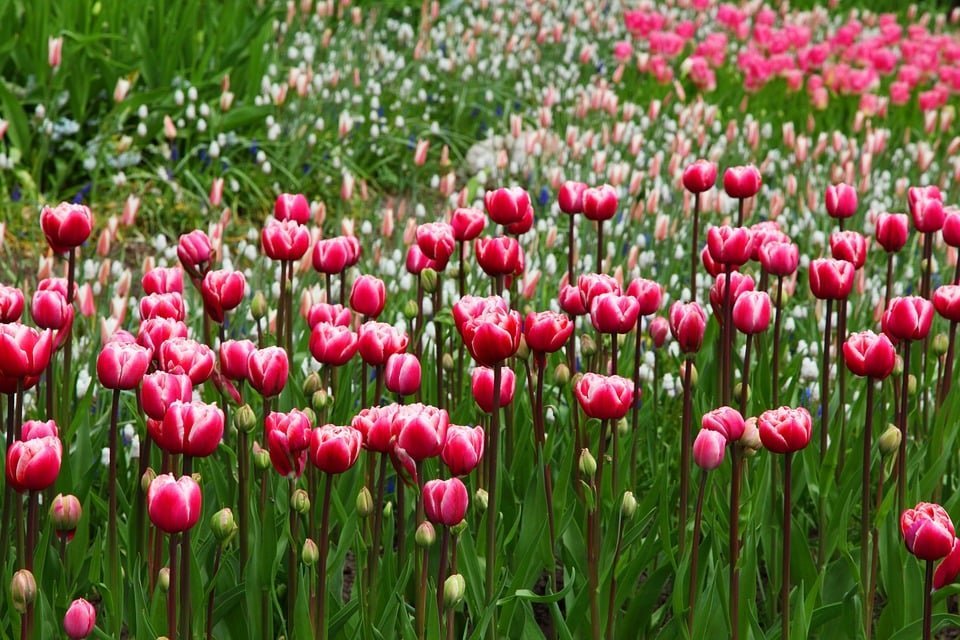
If it’s tulip fever you’re after, look no further than Pashley Manor. In fact, visit during the Tulip Festival which runs from Easter Monday until May and you’ll find 35,000 of them, beautifully arranged into different ‘rooms’ according to colour and species. In case of showers or tulip fatigue, there’s a nice café and gift shop.
In addition to the tulips, spring highlights at Pashley include a very pretty ‘Bluebell walk’ – all very ‘English’. You will have to leave the dogs at home though, and adult tickets cost from £11. The gardens close during winter, opening from the start of April. Definitely up there as one of the best gardens to visit in spring for admirers of bluebells and tulips.
West Dean Gardens, Surrey

Not too far from Pashley is West Dean, near Chichester – with attractions ranging from the 13 Victorian glasshouses to a sunken garden to a 300-ft long Edwardian pergola.
Particularly nice at this time of the year are the spring gardens and pond, with hidden walkways and benches and some good ideas for water features. Check out the restored Victorian summer house too – if you leave wanting your own garden retreat check out our summer house designs (a little smaller in scale and price).
And if you’re more interested in growing food than flowers, the walled kitchen garden is a place of joy. It’s planted on a four-course rotation of potatoes, brassicas, legumes and salads and root crops. If you want inspiration for an allotment, this alone could be worth the £9.50 ticket price. Children under 16 enter for free.
Caerhays Estate, Cornwall
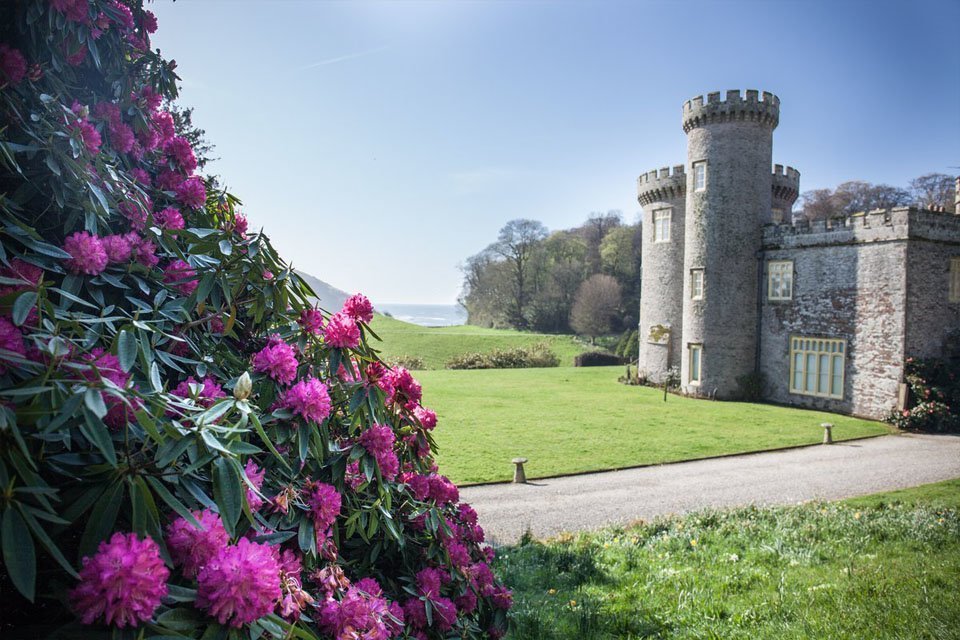
While all the gardens we’ve mentioned are certainly impressive during the springtime, they’re not exclusively spring-focussed (apart from Pashley’s Tulip Festival).
Caerhays, and its 140 acres of castle and gardens, is the exception: it is only open from February until June, by which time the 600-odd species of magnolias it’s known for are in their full majesty. Be warned that these gardens are not particularly manicured or landscaped, but that’s one reason for liking them – you could imagine doing some of this on a smaller scale in your own garden, if you have lots of space and a long timeframe.
Tickets are £9 for adults for the gardens (unguided, but you can arrange guided tours too), or £15 if you want to visit the castle as well. Children go half-price.
Caerhays Estate is not a stereotypical garden, but definitely on of the best gardens to visit in spring.
Killerton, Devon

‘Spectacular’ and ‘stunning’ are over-used words, but if anywhere deserves them, it’s Killerton, both the house and the 6400 acres of gardens. By the start of spring, expect blankets of daffodils, bluebells and cyclamen. on the website telling you the best places to find them.
There’s also an action-packed events calendar, photogenic grazing cattle in many of the fields, a good café and, if you’ve indulged inside said café a little too much, a grand chapel where you can seek absolution!
Adult tickets are £12, though family tickets are available for £18 – there’s plenty to do for kids and dogs, including a forest school for the former.
Brockhampton Estate, Herefordshire

As much as we like them, there’s a chance you’ve had enough of massive country houses with grand old gardens like some of the ones we’ve talked about. If you have, then you’re in luck with Brockhampton.
This medieval manor is both wildflower and wildlife focussed; there are dormice, frogspawn and ducklings in plentiful supply during the spring, and fields full of snowdrops and wild garlic instead of pristine flowerbeds. The six waymarked paths are great for dogs and kids, both of which the Estate welcomes, and access to all of this along with the orchards are included in the £9 adult ticket price.

by Mark Bailey | Jan 18, 2019 | GardenLife Magazine

The best gardening magazines for inspiration
We’re always hesitant to recommend straying from our own GardenLife blog and going in search of inspiration elsewhere. But we must admit that even our monthly offerings can’t cover the whole of garden design and gardening.
So just in case you want a change of scene or a second opinion, there are a wealth of other garden publications, print or online. You may have seen some of them on newsagent or supermarket shelves, but you’re probably missing out on others.
So here’s our list of the best gardening magazines, with a couple of blogs too, which are worth a browse and perhaps even a subscription.

The best high-end glossy gardening mag
Gardens Illustrated is not really about getting down to basics – you won’t find many nitty gritty soil guides here. Rather, it’s all about beautiful projects that will make you inspired and/or green with envy! It’s definitely material for a coffee table or very upmarket reception area.
There’s a practical element in each monthly issue, but the real substance is the gorgeous pieces on grand landscapes all over the world. Think Vogue, only for gardening instead of fashion. It’s probably the biggest gardening magazine in the world, and you can find details about online or print subscriptions here. Definitely top of our list for the best gardening magazines for inspiration.

The best gardening magazine for upmarket homes and gardens?
Another one which hits the shelves and digital newsstands monthly and will come in handy if you win the lottery is Conde Nast’s glossy House and Garden.
Each issue features both grand gardens and grand houses that will make your jaw drop. Expect double-page spreads of gorgeous interior and exterior designs and well-written pieces on entertaining.
If you’re after planting guides, budget gardening tips or other practical information, you may be better off elsewhere but this is definitely worth a browse for daydreaming purposes. Its website is also very good, and free!

Best gardening magazine for tips from TV gardeners
BBC Gardeners’ World magazine is made by the people behind the BBC TV show of the same name. It has an all-star cast of past and present hosts of the show (Alan Titchmarsh and Monty Don seem to be regulars – in fact, the latter is such a fixture that he just goes by his first name. If you have a spare £1750 plus, you could ‘Meet Monty in Provence’; but a Mississippi Cruise with Alan Titchmarsh will set you back a hefty £4995!)
Apart from being starstruck by Monty, Gardeners’ World has a more practical grounding than the likes of Gardens Illustrated. It’ll tell you anything from how to choose tools to how to build a pergola, and there are useful monthly checklists of tasks in your garden and greenhouse.
A subscription gets you access to the “secret garden”. Disappointingly, it’s not an actual place, just an online one, but it does grant access to exclusive articles and videos and so on. There’s an offer on right now which gets you the first 5 issues for £5. Definitely one of the best gardening magazines for down to earth advice.

Two great gardening magazines for practical advice
Garden Answers has a much more practical focus than the coffee-table glossies. There are pages upon pages of planting guides, allotment advice, pest control and mini-projects.
The approach is inclusive and goes out of its way to avoid being intimidating. The ‘Easy Gardening’ section has ‘Weed It or Feed It?’ guides for those who struggle to tell a pest from a perennial. And the reader-submitted garden stories are also a nice touch.
It’s decent value too, at £34 for a year’s sub. One to consider when reviewing the best gardening magazines out there.
Another good practical guide, whether you’re a complete novice or just want some new ideas, is Amateur Gardening. It’s weekly, so the advice will come thick and fast. It’s not exactly cutting-edge magazine design or glossy magazine production, but the articles are easy to follow.
And if you can’t face going outside in the garden till spring, there is advice on indoor gardening and windowsill gardening.

A gardening magazine for those who want to grow fruit or veg
Grow Your Own is another great publication for those like to get a bit of soil under their fingernails.
It really does do what it says on the tin – every month it offers extensive guides to fruit, veg and herb growing for plots of all shapes and sizes. There’s at least 15 of these in every issue, along with the usual DIY mini-project guides. Look out for this in supermarkets and newsagents, or there’s a digital version on the website.
A little extra: two great gardening blogs
Sometimes other people’s glossy photos and project ideas get a bit intimidating, and you just want to identify with the trials and errors of a ‘gardener like you’. There are some really great blogs out there, ranging from inspirational to tragi-comic. Here are a couple we’ve come across recently.
A blog about urban gardening
Many of our readers, like London resident Caro Shrives, don’t have much plot space to work with when it comes gardening. Her blog is about getting everything from avocados to exuberant flowers and shrubs out of her limited space, and her ideas are well within even the complete beginner’s grasp. She includes few good recipes for her produce too.
Good blog about container gardening
Another good blog for those with limited space is Vertical Veg, which focuses on container gardening. Stand-out posts include a short video on how to keep supermarket herbs alive longer – probably the most sought-after piece of gardening knowledge of our age.

by Mark Bailey | Nov 21, 2018 | GardenLife Magazine

Best gardening books for beginners (UK)
Even if you’ve never picked up a spade in your life, there’s a gardening book out there for you. But the question is, which is the best gardening books for beginners? The right gardening book could inspire you with a new garden design, an idea for a water feature or garden building, or simply tell you which way up to plant a bulb.
We’ve put together a list of useful (and sometimes just funny) books about gardening which can help you if you’re just starting out or want to try something new. So without further ado, what are the best gardening books for beginners in the UK?
The best all-in-one gardening book

Monty Don is a household name in the gardening world, more or less a permanent fixture on TV schedules. His The Complete Gardener: A Practical Guide is packed with great photography and advice about – mainly – organic gardening, including fruit and veg.
First published in 2009, the fact it keeps on being reissued is a tribute to its practical and user-friendly approach, and the main reason why we’ve included it in our list of the best gardening books for beginners. There’s a dense 440 pages of advice and most shops offer a discount off its full cover price of £22.
The best gardening books for design inspiration

Has city living handed you a small garden? There’s still loads you can do with your space, even if it really is tiny, as the very handy Gardeners’ World: 101 Ideas for Small Gardens proves. It comes complete with pictures and instructions to help make your plot feel bigger and look fancier, and you should be able to pick it up for not much more than a fiver.

For a more comprehensive tome on garden design, have a look at the RHS Encyclopedia of Design. It covers everything from modernist Japanese gardens to installing proper water run-off. However, these 400-odd pages aren’t cheap, at £30, and are definitely for the more committed gardener.
The best month by month gardening books
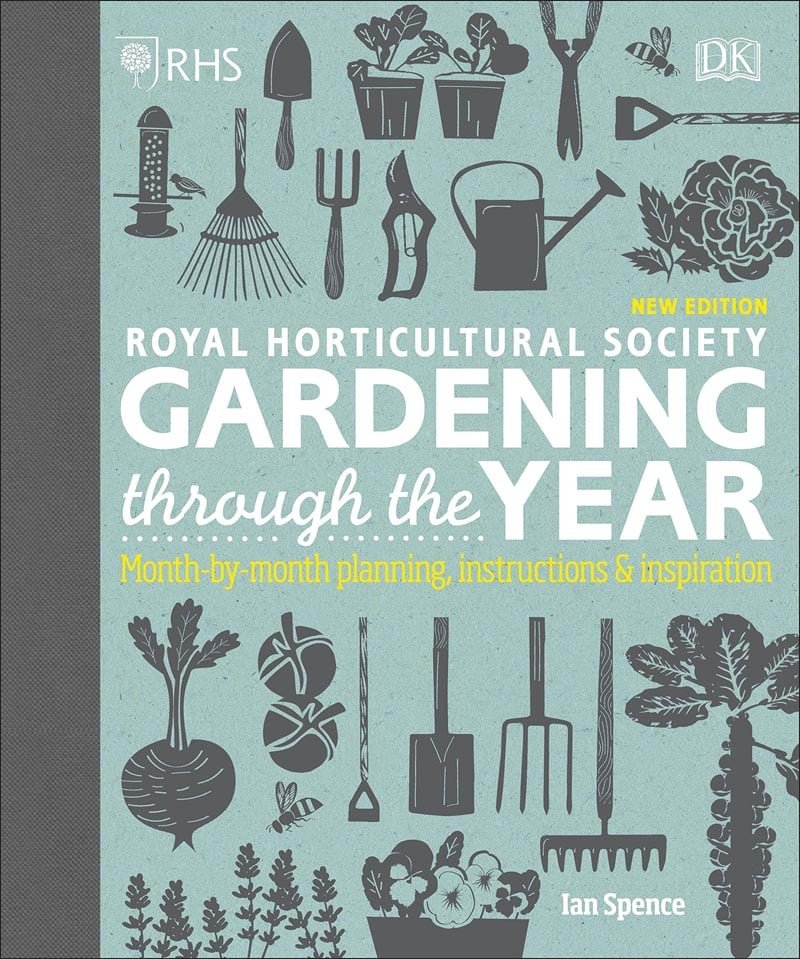
We approve of gardening books that tell you what to do each month – they’re great for beginners and have useful reminders for experienced gardeners too.
Here again, the RHS has a solution – in the form of RHS Gardening through the Year. There’s a lengthy chapter for every month in this thorough encyclopaedia – you’ll find yourself occupied year-round as it tells you what, when and how to plant about 350 species (with photographs and diagrams galore).
It’s an updated edition of what has long been a bestseller and has a particular focus on first-time gardeners; an essential for any list of the best gardening books for beginners. You’ll be set back about £20, which isn’t bad value for its 350 pages.

Another good month-by-month guide is Allotment Month by Month: How to Grow Your Own Fruit and Veg. You’ll find information on just about every fruit and veg under the sun, so it’s excellent for helping you eat your 5-a-day.
Gardening under cover

Another pretty comprehensive read is The Greenhouse Gardener’s Manual, covering everything from basic fruit and veg to pest control and the basics of hydroculture. There are over 300 pages of tips on taking care of what you grow in your greenhouse, and your greenhouse itself. Heating, glazing and venting are also covered and there are plenty of photos.

If a greenhouse is not your thing and your gardening activity is confined to your sitting room or kitchen, take a look at the RHS Practical House Plant Book. This has all the information you need on nearly 200 house plants, and there are eye-catching design ideas like a ‘string garden’ or shrub vivariums.
The best gardening books for dummies
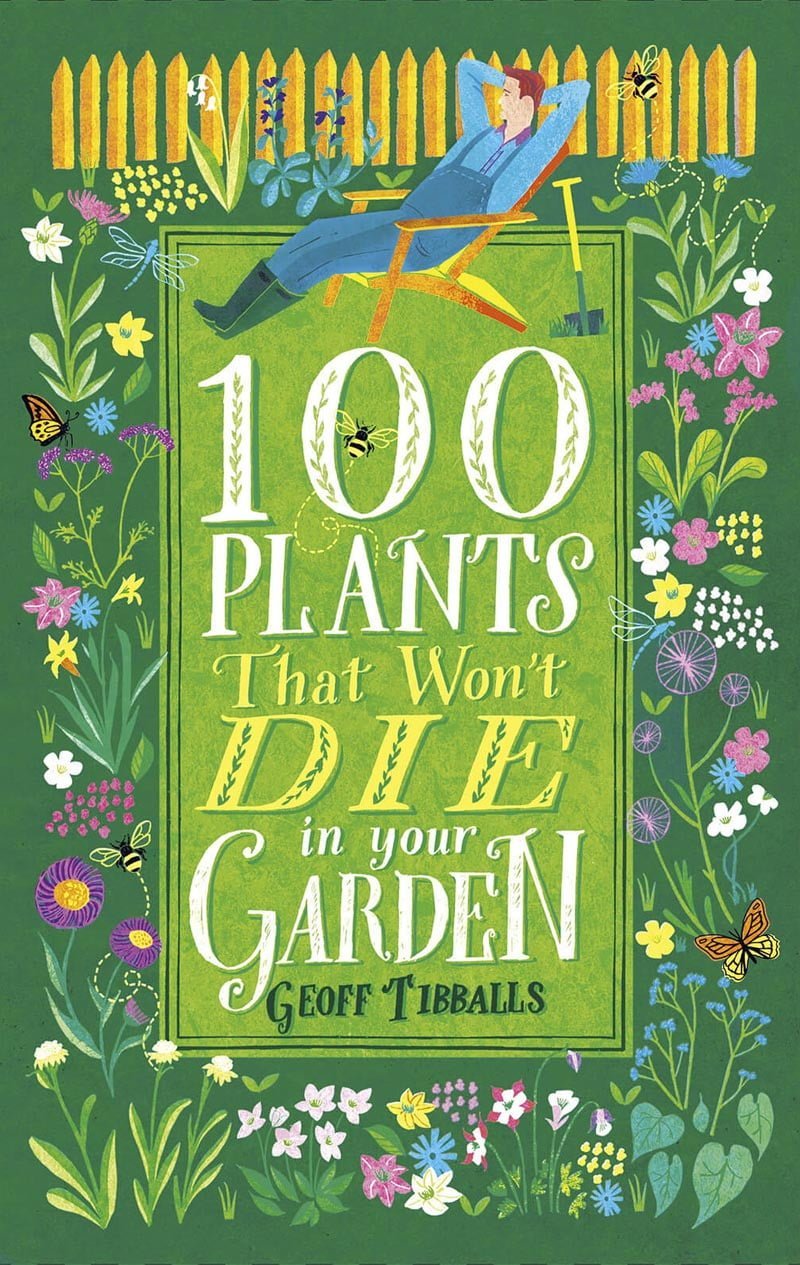
If everything that you have ever planted in your garden has died then this is the book for you: 100 Plants That Won’t Die In Your Garden.
The best garden pond books

Ponds can be a tricky business – a lot of preparation is needed and unlike some aspects of gardening, a trial and error approach is not advised.
Thankfully, the straightforwardly-titled Ponds should sort you out – although it’s short, it’ll guide you through the process of building whichever you style you choose from start to finish.
We also like Ponds: Creating and Maintaining a Wildlife Pond. It’s nicely produced, and its succinct 100 pages have good, practical advice on creating a micro-ecosystem in your garden. Definitely one of the best gardening books for beginners when it comes to ponds.
The best log cabin inspiration
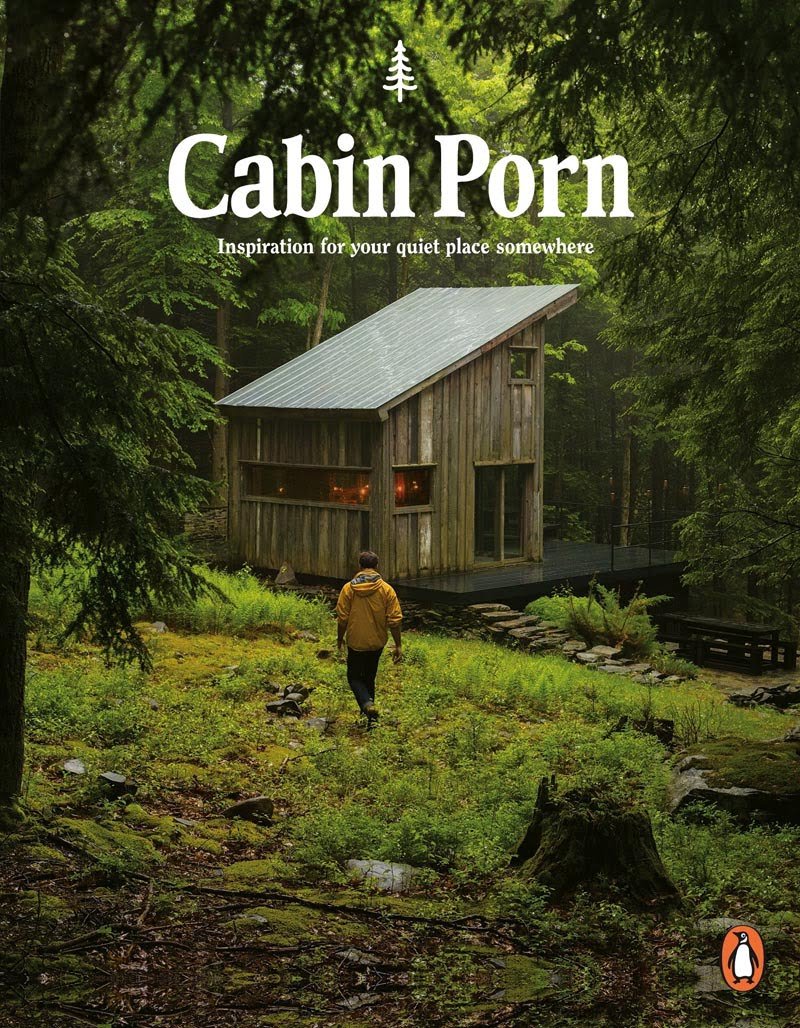
As we’re in the business of making log cabins and summer houses for gardens we had to mention a certain book. Yes, the title Cabin Porn might raise an eyebrow or too, but the compilation of innovative and beautiful log cabins this book showcases is enchanting. Stemming from an online campaign where users submitted their own back garden designs, the result is scores of inspiring designs ranging from quaint DIY projects to full-blown grand residences.
The best garden shed books
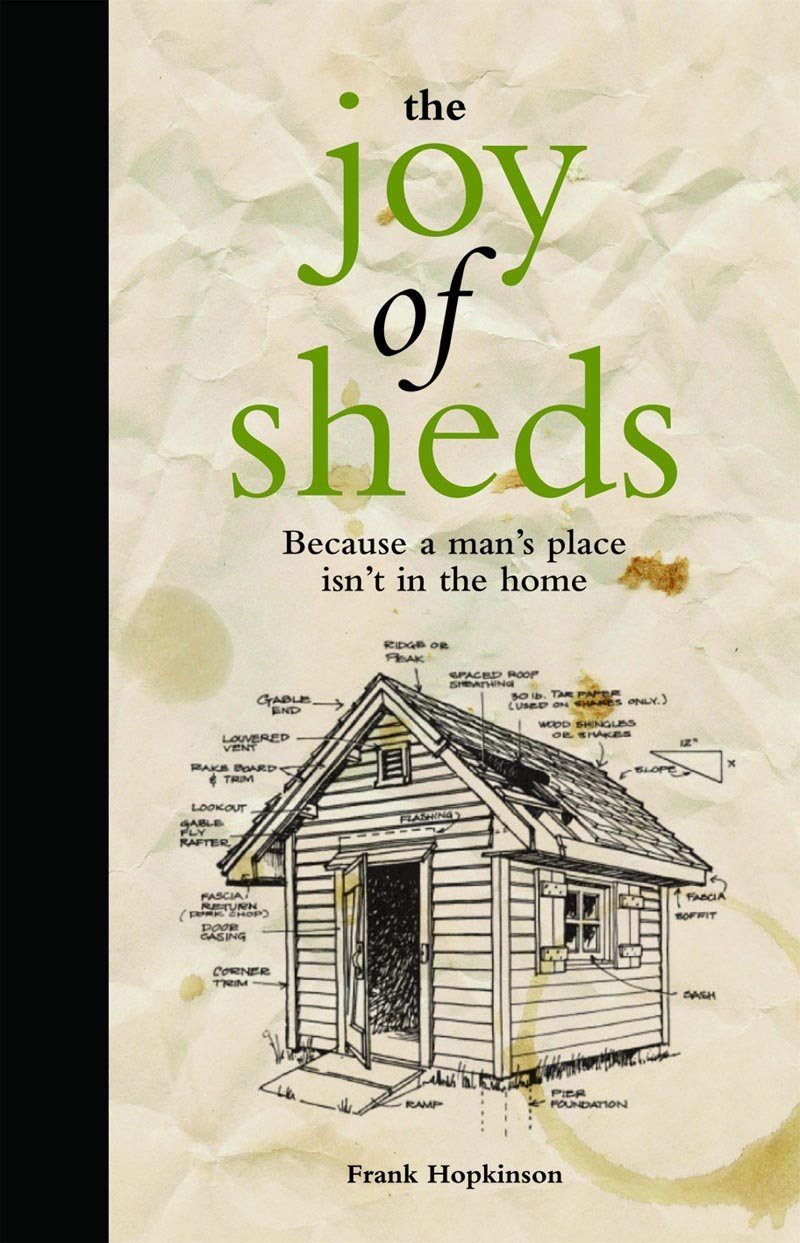
Don’t expect learned technical advice on buying, maintaining and improving your very own shed from The Joy of Sheds; but if you want a funny and idiosyncratic read about just what is so great about sheds, look no further. It’ll even tell you how to ‘pimp your shed’ (their words not ours!)
Another good stocking filler for garden shed lovers is 101 Things to Do in a Shed. It’s quirky, endearing and does what it says on the tin.
The best classic gardening books
Photogenic TV gardeners like Monty Don tend to dominate the displays of gardening books in bookstores and lists of the best gardening books for beginners, but don’t forget the classics – the writers who more or less invented the genre.
Two names always seem to come up here: Christopher Lloyd and Beth Chatto, both now dead (the latter only this year).
Christopher Lloyd was described in his Guardian obituary as ‘the best informed, liveliest and most innovative gardening writer of our times’ (the same obituary also pointed that his 80th birthday party lasted 24 hours, so he certainly does sound lively). His best-known book is The Well Tempered Garden – a classic in the best sense, full of readable, practical advice. It’s a few decades old now, but don’t let that put you off.

Beth Chatto is less of an easy read, but she was famous for her books on specific types of climate or garden. This all started when she set up a nursery and garden in a dry, windswept site in Essex – from this came her book The Dry Garden. Others followed: on damp gardens, gravel gardens, shade gardens, woodland gardens, and drought-resistant planting.
These, of course, are more relevant than ever, given the possible effects of climate change on the UK’s gardens. All are packed with detailed plans and advice and are highly recommended if you have – or want – one of these gardens.
Finally, if you want more ideas on the best gardening books for beginners, we recommend reading through the Gardenista blog. Prices are in dollars, but most of the books are British. So not only will they just right for a UK garden, they’ll also probably be more easily available and cheaper than the blog suggests.

by Mark Bailey | Jul 13, 2018 | GardenLife Magazine

The best city parks to explore in the UK
What are large, green, used regularly by 37 million people, and coming up to 200 years old? The answer is the UK’s city parks, of which there are around 27,000 up and down the country.
Once seen as a radical and revolutionary proposition, they’re now part and parcel of our towns and cities (and some would say the best part). And though austerity poses an existential threat to many city parks (because cash-strapped councils can’t afford to maintain them or are even selling them off), they’re as popular as ever.
So, to celebrate these unsung heroes spanning the country, we’ll tell you a bit about their history, suggest some of the best city parks to explore in the UK, and look at the inspiration you can take back to your own green space.
A little background to our city parks

There are several claimants for the title of the UK’s first urban park (or what we recognise as one today) but a leading contender is Derby Arboretum, which opened its gates in 1840.
This city park still has many of its original Victorian ornaments and structure, including magnificent wild boar sculptures, but has also been updated with playground and sports facilities. Thanks to Lottery funding, it is still in good nick and is very much the same park which Central Park in NYC was based on.
On the horticultural side, it’s home to scores of tree varieties, some of which you will be hard pressed to find anywhere else in the UK. For more information about this lovely city park, including opening hours, have a look at the InDerby.org website.
Finding inspiration and ideas in city parks
Another city park steeped in history is Nottingham’s Arboretum Park, widely thought to be the inspiration for Neverland in J.M. Barrie’s novel Peter Pan.
There’s plenty of heritage here, with some of the original Victorian garden designs and buildings (including an aviary, bandstand and a Chinese-style bell tower commemorating the Crimean War and Anglo-Chinese Opium War). And if you’re into trees, this is the place for you – this city park has over 200 species and varieties, and a nicely laid out tree trail highlighting interesting or rare trees.
And if you’re inspired by the bandstand, admittedly it may be hard to recreate a wrought-iron Victorian in your own back garden, but there are gazebo designs available that could replicate the shape and open sides. Opening times and other visiting details are available here.

Oxford University Parks are also packed full of history, but their popularity for student BBQs makes them thoroughly twenty-first century in atmosphere.
There’s a huge amount to do or watch in these city parks – a botanic garden and nursery where friendly staff are stationed to offer advice on all things green, exercise classes, a cricket pitch where the University team play, other sports pitches, organised walks and bird watching.
For opening times, FAQs or some inspiration from their ‘Plant of the Week’ pages have a look at their website. And if you find yourself irritated at the fact that the Parks’ croquet lawns are not open to the general public, you could always create your own croquet lawn at home, with help from Croquet Online or Jacques London.
The best city parks to explore in the north?

Glasgow Green is currently in its peak festival-hosting season, but for the rest of the year this city park is home to sprawling open lawns and monuments and structures of all varieties. The 50m Nelson column and the wonderful People’s Palace (a museum of Glasgow history and culture in a glasshouse) get the most attention, but there’s also a suspension bridge, weir, various water features and fountains (inspiration for your own garden?), a good café in the Winter Gardens, and a play village.
Best of all, it’s a brilliant place to people-watch – the whole of Glasgow life passes through this city park. Find out more on the council website.
Perhaps more difficult to recreate…

Another city park that’s right at the heart of city life is Edinburgh’s Princes Street Gardens. Better known for concerts, fireworks and views of Edinburgh Castle than for its trees and plants, the Gardens actually house a true horticultural gem: the (working) floral clock.
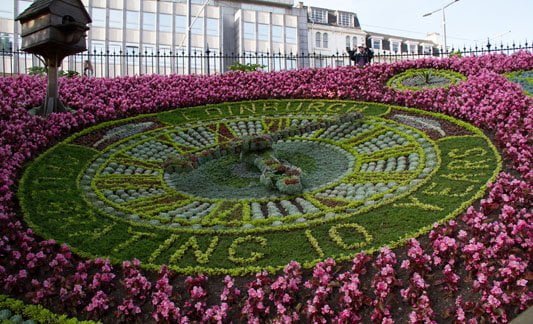
Designed with a different theme each year, it takes a couple of gardeners several weeks to lay out and involves up to 40,000 plants. Recreated the world over from Mexico to Switzerland, it forms the centrepiece of the Gardens and is a real treat to see in the flesh.
Other hidden gems worth exploring
The big city parks tend to get all the attention, but it’s worth seeking out so-called ‘pocket parks’ around the UK’s cities and towns.

For example, in the heart of London, nestled a stone’s throw from St Pauls Cathedral hides Postman’s Park. Built near the former Post Office headquarters and once popular with the postmen who worked there – hence the name – it’s a serene green bubble in the heart of the Big Smoke.
As well as providing a great place to escape the crowds if you’re in this part of London, it may provide some ideas for your own patch: a quiet bench and pergola or gazebo with ivy running up and the end of your garden could nicely recreate this garden’ soothing effect and be a real haven from the cares and stresses of life.

Another well-kept secret in the capital is the conservatory at the Barbican Centre. Although only open on Sundays, it houses a mammoth catalogue of over 2000 tropical plants, trees, and even fish. Should you fancy a visit, opening times are available here.


















































